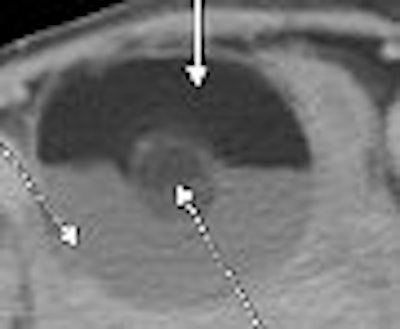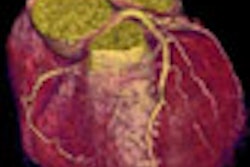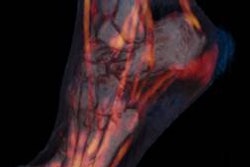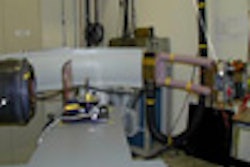
Introduction
A dermoid is an ovarian mass composed of tissue arising from endo-, meso-, and ectoderm. Smaller ones (less than 4 cm) are asymptomatic and are left in place. Those larger than 4 cm are often removed because of a higher risk of torsion.
This benign tumor, descending from germinal cells, occurs mainly in young women (20 to 30 years of age) and represents 18% to 20% of benign ovarian tumors. In most cases, dermoid cysts are unilateral, but they do present bilaterally in up to 25% of cases.
Clinical history
Female, 31, with pelvic pain and palpable mass increasing over the past few months. No previous history of surgery.
Physical and CT exams
Tender palpable pelvic mass. Possible ovarian mass, pyosalpinx, or appendicular abscess. Referred for a CT pelvic scan.
Bowel preparation was given 24 hours ahead of the examination, followed by a soap enema. Three hours prior to the examination, Gastrografin (Bayer Schering Pharma, Berlin) solution was given rectally three hours prior to the CT exam. Noncontrast scans followed by IV contrast scans, using 80 mL of Iopamiron 370 (Bayer Schering Pharma), were performed with120 kVp and 100 mAs.
 |
| Top arrow on left of image points to fluid; top arrow on right is fat. Bottom arrow points out Rokitansky nodule. Image taken on a Sytec SRi CT scanner and processed on an Advantage 4.2 workstation (GE Healthcare, Chalfont St. Giles, U.K). Image courtesy of Dr. Shamim Malik. |
Findings
A pelvic mass, measuring 6.0 x 6.2 cm was demonstrated. The mass had a thin wall with a fat-fluid level with a Rokitansky nodule of 1.9 cm in diameter, at the junction of the fat-fluid level.
No ossification or calcification within the mass is seen. Wall of the mass enhanced with contrast. The mass caused extrinsic indentation of the urinary bladder, uterus, and sigmoid colon. Both kidneys were normal. No para-aortic or pelvic adenopathy was seen.
Diagnosis
Mature teratoma or dermoid being a fat density mass with a fat-fluid level present. The high-density Rokitansky nodule was composed of hair and other components, and floating in the center of the mass. Calcification was not present.
Differential diagnosis
Other disease states that share similar characteristics of dermoids include the following:
- Simple ovarian cyst
- Intracystic bleeding
- Complex adenexal mass
- Pyosalpinx/ovarian abscess from pelvic inflammatory disease (PID)
- Malignant ovarian neoplasm
- Endometriosis
- Extra ovarian masses (e.g., unopacified bowel, bladder diverticulum, peritoneal inclusion cyst, focally entrapped fluid from PID or surgery)
Discussion
Mature teratoma will manifest as a soft-tissue density mass on CT. Mature teratoma may present with ossification or teeth. Torsion or bleeding can be seen on CT as wall enhancement and high-density blood, respectively. These are typical features for a dermoid and point to its radiological diagnosis.
The patient initially had an ultrasound done in a peripheral center. As the mass was grew more painful, torsion of the ovary was suspected, but a dermoid had not been diagnosed. If a dermoid is more than 4 cm in size, the chances of torsion are higher and hence removal is advised.
Contrast CT was performed with 10-mm slice thickness. As the diagnosis was obvious, imaging with thinner slices was not done to reduce radiation affects to the pelvis.
Conclusion
Mature teratoma is easily diagnosed on CT by looking for a fat-fluid level and a central nodule floating in it. In addition, tumor markers such as alfa-fetoprotein may be positive in endodermal sinus tumors. Choriocarcinoma elaborate chorionic gonadotrophins. CA125 is positive in carcinoma of the ovary.
By Dr. Shamim Malik
AuntMinnie.com contributing writer
June 21, 2007
Dr. Shamim Malik is a private practice radiologist at the Crater X-Ray Clinic in Nakuru, located in the Rift Valley Province of Kenya. The entire Rift Valley, with a population of 9.3 million, is served by three CT scanners.
The opinions expressed in this review are those of the author, and do not necessarily reflect the views of AuntMinnie.com.
Related Reading
Oophorectomy cuts breast, ovarian cancer risk for those with BRCA1/2 mutations, May 28, 2007
Transvaginal sonographic screening may catch ovarian cancer early, May 28, 2007
Symptoms common before ovarian cancer diagnosis in older women, May 8, 2007
Copyright © 2007 AuntMinnie.com



















